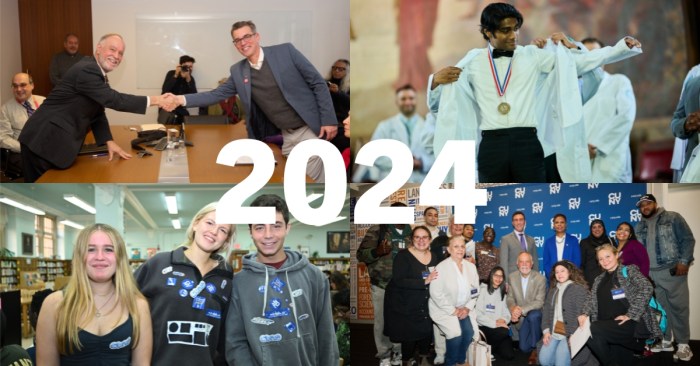At CUNY, much of our mission — and the pride we take in it — centers on the work we do in opening doors to economic and social mobility by guiding students from underrepresented groups to their first college degree. Just as important, but often overlooked, is our excellence in research, an enterprise that is fueled by more than 10,000 researchers and staff with growing support from public and private funders. Collectively, their cutting-edge work is powering the engine of research and innovation downstate and in New York City.
The University’s research grants, which have been administered by the Research Foundation of CUNY for 60 years as of this week, total about $500 million each year — but through the first half of this fiscal year, which runs through June, already amount to $417 million. That’s a CUNY record; if the trend continues, the University will end the fiscal year having received the largest amount of external research funding in its history.
CUNY currently has more than 2,100 research grants for projects that are being carried out by researchers from the Graduate Center and our graduate and professional schools and every one of our 18 undergraduate campuses. They are working to alleviate disparities in public health and pursuing advances in computer science, data science and biomedical engineering, to name just a few areas in which our researchers are making measurable differences for the people of our city, state and nation.
Few areas of science are more challenging, and more urgent, than climate change. CUNY researchers are conducting dozens of projects that will help New York City cope with severe weather events and contribute to the global battle to reduce carbon emissions. In one recent study, funded by a $1million grant from the National Science Foundation, researchers at CUNY’s Advanced Science Research Center found that more than a third of the city is covered by trees and other greenery that absorbs as much as 40% of the metropolitan area’s carbon emissions in the spring and summer. It’s a finding that can inform strategies for reducing greenhouse gases in urban areas everywhere.
Since the pandemic, researchers at the CUNY Graduate School of Public Health and Health Policy have led the way in a wide array of COVID-related studies. In one study, SPH faculty are exploring the low vaccination rates among people with mental disorders that puts them at higher risk of severe illness and death. With $3.2 million in funding from the National Institutes of Health, the researchers are working to quickly develop interventions that can be used nationwide to reduce vaccine hesitancy among people with depression and anxiety.
As important as this research is for the societal benefits it delivers, it also helps sustain CUNY’s great success in turning out diverse graduates with advanced degrees, especially in the sciences. As we continue to strengthen the University’s research enterprise, we are also working to attract more students of color to Science, Technology, Engineering and Mathematics (STEM) fields in which they have long been underrepresented. The Simons Foundation recently awarded the Graduate Center a $4 million grant that will allow students to enroll tuition-free in a new master’s program in astrophysics designed to prepare them for doctoral programs as well as careers in STEM.
Beneficial in More Ways Than One
CUNY’s 30,000 graduate students are the next generation of leaders, researchers and innovators, and many are part of the University’s efforts to bring more diversity to science. These students, and the research they are doing with their faculty mentors, is part of what distinguishes CUNY as a research powerhouse that is focused not only on real-world public needs, but also on breaking down long-entrenched barriers to opportunity.
Our enrollment in science and engineering doctoral programs, for example, is significantly more diverse than the national average: 12% of CUNY Ph.D. candidates in these fields are Hispanic, compared with 7% nationally; and 7% are Black, compared with 4% nationwide. Twenty percent of the Graduate Center’s full-time students come from underrepresented minorities, greatly exceeding those reported by Stanford (13%), Cornell (11%), Columbia (9%) and top public research institutions such as the University of Michigan-Ann Arbor (12%) and the University of Texas-Austin (16%).
CUNY is continually building its research programs by leveraging its vast scale to forge dynamic partnerships both inside and outside the University. Our funding sources are equally diversified and wide-ranging, but additional state and city investment is needed. Put together, they position CUNY for sustained, long-term impact as a leader of innovative and consequential research in the public interest.






















